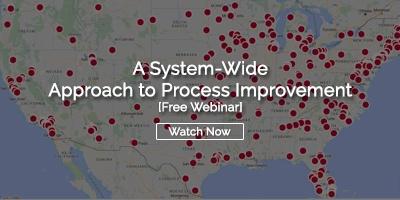 Business process improvement is a management practice that helps leaders leverage several tools and techniques to analyze their processes and uncover areas where improvement in accuracy, quality, and efficiency can be achieved. The leaders then work with process operators to redesign those processes to improve productivity and gain the expected improvements. Business process improvement techniques work by systematically identifying the operations, activities, or employee skills that might be enhanced to result in better workflow, more efficient use of resources, and better overall business results. Business Process Improvement (BPI) is also sometimes called functional process improvement.
Business process improvement is a management practice that helps leaders leverage several tools and techniques to analyze their processes and uncover areas where improvement in accuracy, quality, and efficiency can be achieved. The leaders then work with process operators to redesign those processes to improve productivity and gain the expected improvements. Business process improvement techniques work by systematically identifying the operations, activities, or employee skills that might be enhanced to result in better workflow, more efficient use of resources, and better overall business results. Business Process Improvement (BPI) is also sometimes called functional process improvement.
The Goals of Business Process Improvement
Organizations use process improvement to reduce the time it takes to complete processes, reduce material and human resources waste, and improve the quality of the products or services delivered to the customer. In some cases, BPI is initiated to comply with regulations and rules that govern specific industries or products.
BPI methodologies can also help an organization meet customer requirements and achieve business goals more efficiently. Business process improvement can be applied to any functional area of an organization, including production, HR, IT, sales, accounting, and facilities management. In healthcare, BPI is used for both clinical and administrative processes.
How Business Process Improvement Happens
Ideally, BPI has targeted the business needs and goals that the processes support. The ultimate goal is to refine each process until it produces optimal results.
Leaders typically start with business process mapping the existing processes within their organization. They then analyze these value stream maps to look for potential improvement opportunities and understand what adjustments could reduce waste and add value.
Next, they focus on reworking and reorganizing processes and adjusting the people who operate the process. Leaders might also invest in new tools or technologies to improve the function or structure of their improvement efforts.
Popular Business Process Improvement Methodologies
Leaders looking to bring business process improvement into their organization's culture often use one of the structured methodologies and philosophies that world-class organizations have developed to structure continuous improvement. However, it is also common to pull various ideas from each method that make the most sense for a given organization.
Six Sigma
Six Sigma is a business process approach that started at Motorola and later became central to the strategy at General Electric. It has been used widely for manufacturing operations, but the core ideas can also be applied in other industries. The approach helps organizations measure defects and inconsistent process results to deliver perfect products or services.
Six Sigma methodologies rely heavily on a sub-methodology called DMAIC for improving existing processes. DMAIC consists of the following steps:
Define the problem, the opportunity for improvement, and the project goal.
Measure and document the performance of the current process.
Analyze the process to find the root causes of any defects.
Improve the process by making changes that impact the root causes.
Control the improved process to identify and adjust for any deviations before they cause defects.
Other tools often support the DMAIC process, such as fishbone (Ishikawa) diagrams. Sometimes called cause-and-effect diagrams, this visual tool can help team members brainstorm the potential cause of a defect. In what looks like a set of fishbones, the head of the diagram contains the problem statement, and the "bones" branch out into different categories of potential causes.
Six Sigma relies the most on data and statistics to guide decisions among the business process methodologies. Using DMAIC, Six Sigma organizations can identify the precise economic impact of process improvement.
Lean Manufacturing
The Lean business process improvement methodology is built around eliminating waste in all of its forms. Like Six Sigma, Lean began in the manufacturing sector, but its principles make sense for organizations of every size and type.
Lean leaders start by evaluating each process's value stream. The value stream includes all of the activities that a customer would pay for (value-added) and the activities in the process that are possibly necessary but non-value added.
Any activity that doesn't add value or isn't necessary as part of a regulation or policy is considered waste. Lean leaders break down waste into eight categories.
Transportation: The unnecessary movement of products or raw materials.
Inventory: Storage of materials or products that aren't needed to process current orders.
Motion: The excessive movement of people or equipment.
Waiting: Interruptions in production or periods of inactivity.
Overproduction: Production of products or process inputs before demand.
Over-processing: Adding features or product complexity that does not add value to the customer.
Defects: The effort in fixing and monitoring defects in process outputs.
Human potential: Underutilizing the skills and knowledge of employees.
Total Quality Management (TQM)
Total Quality Management is a business process improvement methodology that has been around since before Lean and Six Sigma. It gathered a lot of attention when the US Federal Government started using it in the late 1980s. The practice of TQM varies from company to company, but it is based on the following principles:
- Organizations should follow a strategic and system-wide approach to achieve their goals and objectives.
- Only the customer can determine the level of quality.
- All employees are aligned around common goals. Effective, frequent communication and ongoing training ensure that everyone understands the customer's definition of quality and strives to achieve it.
- Organizations should standardize the required steps of every process and track key performance measures to detect any deviations.
- Organizations must constantly look for ways to be more efficient and competitive.
TQM companies have used many different tools to uncover and solve quality issues. For example, when the US Navy implemented their TQM plan, they used several tools to measure quality, including the fishbone diagram we mentioned earlier, check sheets, and flow charts.
Many organizations practicing TQM use the PDSA cycle. PDSA (Plan, Do, Study, Adjust) is also called the Deming cycle or the control cycle. Others use PDCA cycles (Plan, Do, Check, Act), a similar structured improvement approach.
Toyota Production System
The Toyota Production System (TPS) approach is known as just-in-time production. It was created by Taiichi Ohno in Japan following World War II to speed production and reduce the cost of inventory. It is based on the Kaizen way of thinking that embraces minor incremental improvements initiated by employees at every level. Another key tenet of TPS is only to produce products or parts when needed to avoid large inventory or products or materials.
The four main principles of TPS are:
- Let your organization's long-term philosophy inform decisions rather than near-term financial objectives.
- Identify the proper process to produce the desired results by:
- Mapping process flow to find problems quickly
- Deploying a pull system to eliminate overproduction
- Use visual controls, such as Kanban to manage the process and avoid problems.
- Use only reliable technology.
- Invest in employees to develop leaders who embody your philosophy and teach it to others.
- Develop a culture that supports continuous learning and improvement. Always understand the root cause of a problem before implementing a solution.
TPS organizations often leverage A3 reports for problem-solving. A3 reports are one-page documents that identify and communicate critical process insight. The report helps workers get to the heart of problems and solve them quickly through incremental improvements and the PDSA cycle.
Using business process improvement methodologies, organizations can overcome their most challenging obstacles and reduce resistance to change. Leaders can align improvements with business goals and effectively communicate the strategy.




Add a Comment